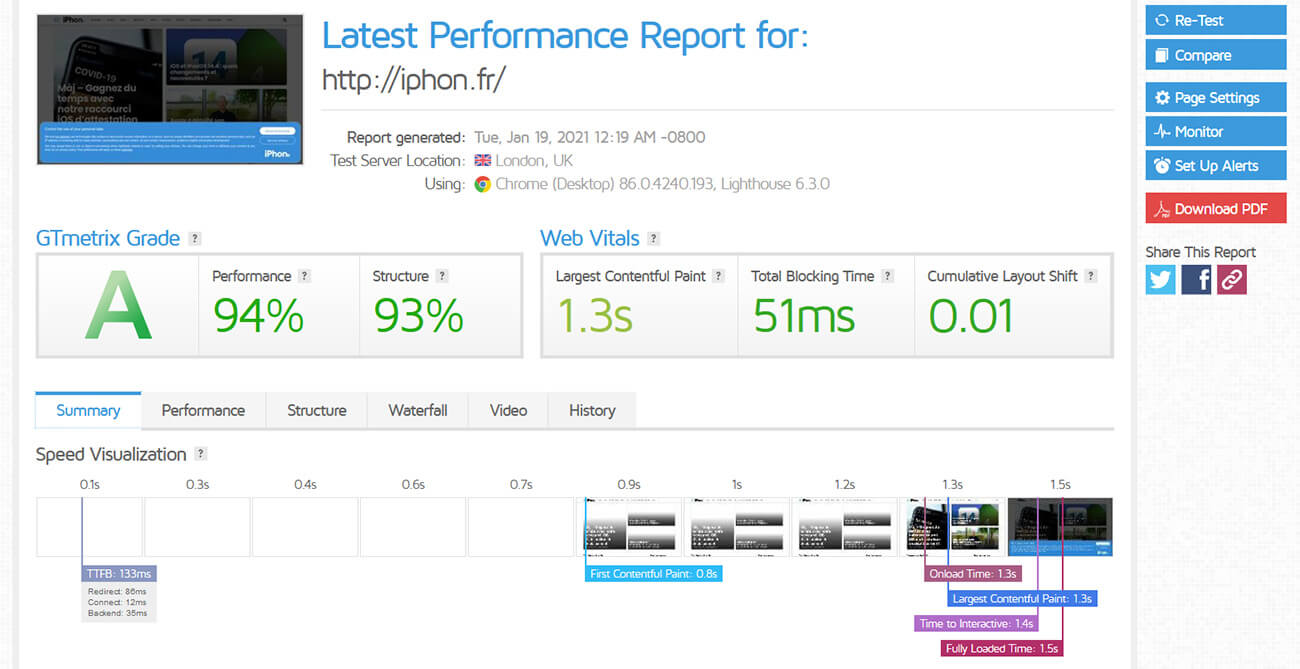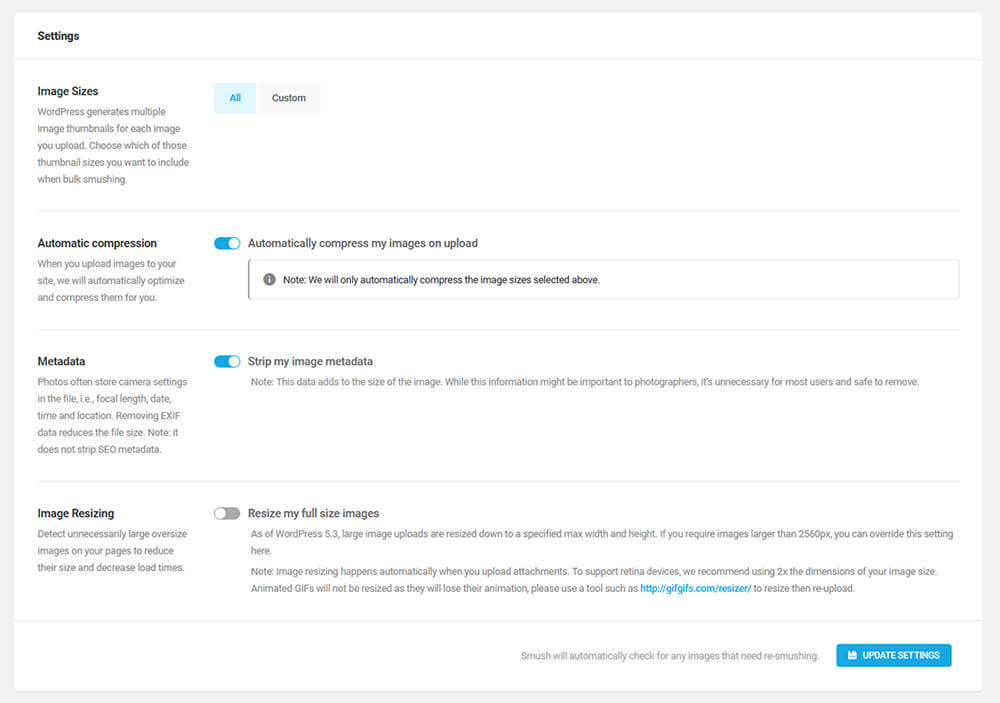Having a high-performance, fast-loading website is extremely important in 2024. But what exactly is a fast site? At what loading time can we be satisfied?
There is no “perfect” value but to give you an idea, here is a scale of loading times and their acceptability:
- Less than a second:parfait
- 1 to 3 seconds:satisfying
- 3 to 7 seconds:very average
- 7 seconds or more:bad
You should know that according to several studies,a visitor will tend to leave a site if it does not load after 3 seconds. Are you far from the announced values? Don't panic because we are going to explain to you how to improve the speed of a website.
What impact does the speed of your site have on its SEO?
But before explaining to you what modifications you will be able to make, we want to explain to you what impact the speed of your site has on its SEO.
As you could have read just above, the loading time of this will have a direct impact on the behavior of your visitors. Which will inevitably have an influence on the SEO of your site. Everything is linked.
Indeed, Google takes this aspect into account since it uses robots to browse all the websites that exist. This allows it to evaluate the content offered on your site, but also the browsing experience offered.
If the latter is not good, your website risks being penalized and therefore losing positions on search engines.
On the contrary, if your site is quick to navigate, and what's more, the content is quality, then you will inevitably improve your natural referencing. The performance and SEO of a site therefore go hand in hand.
To go even further, if you have a platform that aims to sell products, your conversion rate (CTR) will be much higher with a high-performance site. You will have understood:you have everything to gain by having a site optimized from a speed point of view.
How to measure the speed of your site? With what tool?
Our favorite tool for measuring the performance of a site as well as its loading time is GTmetrix:gtmetrix.com.
From this site, you will have all the necessary information to evaluate the performance of your site. Better yet, it will give you ideas regarding aspects that deserve to be improved.
Here is a screenshot of the GTmetrix interface:

© iPhone
In a few clicks, you will be able to see how your site is doing from a loading time point of view, what slowdowns have been noted, and you will have a score evaluating overall performance.
Obviously, A is the best grade and the closer you get to 100% for the “Performance” and “Structure” aspects, the more it will be a good sign.

© iPhone
As you can see in the first screenshot of GTmetrix, you will find the “Largest Contentful Paint”. This is the indicator that will tell you how long it takes for the main elements of your site to load (those necessary for hassle-free navigation).
Before diving into the recommendations that follow, we advise you to enter the URL of your site in order to test its speed on GTmetrix.
To get results as close as possible to reality, consider creating an account on GTmetrix (it's free) in order to be able to select the test server used by the platform (otherwise you will use a server in Canada by default, which is not conclusive for measuring the performance of a site aimed at a French or European audience).
How to Improve and Optimize Site Speed and Performance – Complete Guide
The results of the speed test you just performed on GTmetrix are not good? Is your WordPress site taking too long to load? Is it extremely slow? In this case, we advise you to carefully read our 10 tips which will allow you to improve the overall performance of your platform.
Find a good web host
The most important thing to consider is: the performance offered by your web host. Do they live up to your expectations?
If the answer is no, then we advise you to immediately change your creamer as they say. To make this process easier, please note that in the following lines we will recommend a host offering free migration. Everything will be managed by the host's technical teams, you will not have to do anything.
Which host do we think is the best? It isHostinger. If you have not had the opportunity to read our full opinion on it, do not hesitate to click on the link placed in the previous sentence of our article.
Hostinger is aquality and inexpensive web host. It will give you excellent performance, especially if you have a WordPress site. Indeed, the host will give you access to LiteSpeed technology which can be coupled with the LiteSpeed Cache cache plugin.
© Hostinger
You will better understand their usefulness in the rest of our guide. To put it simply, this duo will allow you to greatly improve the speed of your site. And all this in a relatively simple way.
Otherwise, Hostinger also has the advantage of having several data centers in Europe, which will allow you to host your site as close as possible to the visitors you want to attract.
If you are interested in migrating your site to this host, please note that we have a promotional code to offer you:count. With it, you can obtain an additional 10% discount when ordering your accommodation.
Please note that Hostinger offers a 30-day money-back guarantee.
Install a WordPress cache management plugin
Nothing forces you to change web host. Now as said, this is very often the most blocking point when trying to have a fast and efficient website.
That said, you should not neglect the choice of a cache management plugin either.
You don't yet have one installed on your WordPress site? If this is the case, this will have to be remedied quickly.
Which cache plugin to use for your site?Our number 1 recommendation is LSCache. The only small problem, to take full advantage of it, your web host will need to support and use LiteSpeed Server technology. Unfortunately, this is not the case for everyone. However, atHostingeretPlanetHoster, this will be the case.
If you are unable to access LiteSpeed Server, we recommend either the “W3 Total Cache” or “WP Super Cache” plugin. These are two completely free WordPress plugins which will allow you to effectively manage your site's cache, but also to reduce the size of CSS, JS files... We will also come back to this aspect in the rest of our guide explaining how to improve the speed of a site.
Once you have been able to install one of these plugins, consider enabling cache management, as well as other settings that you find interesting.
Optimize your site images
A website is very often made up of a lot of images. Is this the case for your blog? Your portfolio?
Even if you only have very few images online, you will be able to make significant performance gains by optimizing your images.
How to optimize your images? And what exactly do we mean when we talk about optimization?
When talking about optimizing images, we think of reducing their size. Very often, we find extremely heavy and large images on websites.
To remedy this, you will have to use the correct image format (generally .JPEG or .PNG – it all depends on the case). Then, we recommend that you use a plugin that allows you to compress your images without necessarily impacting their overall quality.
Our favorite WordPress plugin is WP Smush. It is available for free and will optimize for you the images that you will put online on your site. This way, your pages will be much lighter, and therefore faster to load.

© iPhone
After installing the plugin, you can configure it as you wish so that compression is done automatically… or on demand. WP Smush is even able to resize images for you.
Use a lightweight and efficient WordPress theme
Improving the speed of your site also involves choosing a lightweight theme, with clean and well-optimized code. Many people tend to ignore this aspect.
However, it also allows you to improve the speed optimization of your site, whether on WordPress or another CMS.
Which theme to choose on WordPress, for example? We advise you to take a look at our ranking of the best free themes. With a theme like Astra, you will have one of the best performing themes, with supporting evidence (available on the official Astra website).
Now this is not the only solution. You will realize this by browsing our complete listing.
To summarize our thinking, a powerful and fast theme is: few requests generated, low weight, maximum code optimization.
Clean up your database
By installing plugins, adding features, working on your platform, deleting plugins, your site's database will be cluttered. This is why we must try, on a regular basis, to clean and optimize it.
How to go about it? Well once again, it's relatively simple because there are plugins that will allow you to do this in a few clicks.
The WP-Optimize plugin is the perfect example. In addition to giving you the ability to clean your database, it will allow you to delete from a central dashboard:
- spam/unwanted comments
- revisions of your articles (if you have too many)
- your site's trash can
You can also optimize the database tables in one click:

© iPhone
Reduce (or minify) the size of CSS and JS files
Have you already applied all the above tips to optimize the speed of your WordPress site? The effects are not felt? In this case, also try to reduce the size of the CSS and JS files.
Most caching plugins will give you the ability to do such a thing. This is also made possible by LiteSpeed Server + LSCache which are offered with all Hostinger WordPress or shared hosting:
You will see that very often, by doing a speed test via GTmetrix, the cause of slowness can come from CSS and JS files added following the installation of a plugin, a theme, etc.
If you decide to use LiteSpeed Cache to optimize all of this, you will only have to go to the “Page Optimization” tab then “CSS Settings”:

© iPhone
Deploy a CDN
What is a CDN? This is the English term for a Content Delivery Network (Content Delivery Network or RDC). If we talk to you about Cloudflare (the biggest player on the market), maybe that means more to you?
Using a CDN will allow you to greatly improve the speed of your site.
How does it work? Your site files will be hosted on a large network of servers around the world. So, when a visitor tries to access your platform from the United States, he will load your site from one of the American servers in your CDN.
This will drastically reduce loading times since your site data will not need to travel great distances. If your goal is to reach international visitors, this is a real plus.
Additionally, using a CDN like Cloudflare will give you the opportunity to benefit from additional anti-DDoS protection.
As our explanation suggests, after using several different CDNs, we recommend Cloudflare to start. It has the advantage of having a substantial network of servers and of being free.
Deactivate and uninstall plugins that you don't use or no longer use
As we have already suggested previously, it is important to clean your site and its database.
This also involves sorting the plugins and extensions that are installed. There is no point in keeping plugins that you no longer use. Consider uninstalling them, then cleaning your site's database to get rid of the plugins.
Having too many plugins installed can clearly slow down the speed of your site.
So try to use only the most important and interesting plugins. For example, if some plugins do things that you could do manually and simply, try to do without them.
Implement Lazy Load
The other thing we can suggest implementing on your site to improve speed and loading times is Lazy Load. By implementing “lazy (or delayed) loading” of the content of your pages, visitors will only load the content they consume.
Images in an article will only load when the visitor scrolls down to them. This will allow you to greatly reduce the loading time of your pages (if this is a problem for you currently).
Once again, to set this up, you can rely on a certain number of plugins, including certain cache management plugins.
LiteSpeed Cache offers lazy loading of images. Here's how to enable the option: click “Page Optimization” > “Media Settings” > switch the “Delayed Image Loading” setting to “Active”:

© iPhone
Reduce the number of redirects
Permanent redirects (if you delete certain pages or articles) are interesting. This is much better than having 404 errors. Now, this will definitely increase the loading time of your pages.
This is why you should, wherever possible, try to restrict the use of redirects.
To have an overview of the redirects made on your site, we advise you to use the Screaming Frog application.

Interface de Screaming Frog © iPhon
The latter will also give you the possibility of tracking down and repairing dead links.
Conclusion
As you may have noticed, improving the loading speed of your site is a task that will require a lot of effort and adjustments. However, the game is worth it since it will have a more than positive impact on your site, its traffic, as well as the satisfaction of your visitors.
Before diving headlong into optimizing the speed of your site, take the time to carefully analyze the tests and measurements carried out beforehand. This way, you will be able to target the aspects that will offer you the most significant gains in terms of performance.
Take it step by step, there is no point in implementing all of our recommendations at once.
And don't forget: don't neglect the choice of your web hosting. It is generally he who will have the most influence on the overall performance of a site. In this regard, we would like to remind you again thatour recommendation is the host Hostinger.
It has the big advantage of offering inexpensive and efficient hosting, as well as free migration so that you can change host without the slightest hassle.






